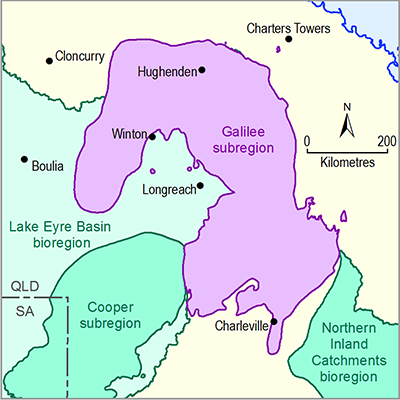Merrick and Alkhatib (2013) provide details on the China First (Galilee Coal) groundwater model as part of the China First supplementary Environment Impact Statement.
Some basic parameters for the steady-state model are outlined in Table 5. Model cell size was of 100 m over the mine areas, coarsening to a maximum of 1 km at the model boundaries. This model extent was made sufficient enough so as to be able to report on: drawdown and recovery relating to the China First Coal Mine only; cumulative drawdown and recovery by China First Coal Mine and the adjacent Alpha Coal Project, but not the South Galilee Coal Project, as drawdown data relating only to South Galilee Coal Project (and not incorporating other nearby mines) could not be obtained; and assessment of potential impacts to GAB aquifers and springs.
The model contains 11 layers and has a transient runtime of 200 years, of which 30 years represents the mining period. The uppermost model layer represents alluvium and regolith. Layers 2 and 3 represent the regolith, Moolayember Formation, Clematis Group and Rewan Group. Layers 4 to 10 detail the various hydrostratigraphic units in the upper Permian coal measures while Layer 11 is the Joe Joe Group. The grouping of all geological units above the Rewan Group into a single model layer compromises the ability of the model to resolve changes in groundwater level in individual units above the Rewan Group, such as in the Clematis Group or in the Cenozoic deposits.
General-head boundaries are assigned to the model domain edges, to simulate inflow from the west and outflow to the east and north-east. All surface water bodies were represented using the MODFLOW River package. Unlike the DRAIN package, the RIVER package allows for both flow into streams (discharge) and out of streams (recharge). Water depths varied from 0 to 2 m based on the size and flow regime of the stream (Merrick and Alkhatib, 2013). Natural springs, open-cut mines, and underground mines were represented as drain cells. In the open-cut and underground mine areas, as mining progressed, the predictive model was able to incorporate changes to recharge, hydraulic conductivity and storage.
Rainfall-recharge values for the model were: alluvium, 1.1 mm/year; Clematis Group-Warang Sandstone, 30 mm/year; Rewan Group and Dunda beds, 6.7 mm/year; and Bandanna Formation, 1 mm/year. Recharge from rivers and creeks totalled 30 ML/day.
Over the life of China First Coal Mine the cumulative aggregate inflows for the open-cuts averaged 2.6 GL/year, and for underground development, 23.1 GL/year. The groundwater modelling predicts that the GAB springs and GAB aquifers are unlikely to be impacted. For some streams it was predicted that leakage to shallow aquifers would increase by up to 1.1 ML/day. Once the mine is closed, predictive modelling suggests that groundwater levels would substantially recover, with only minor groundwater sinks being permanently developed within the immediate vicinity of the mine voids.
Post-mining groundwater levels are simulated by running the model for 200 years with no mining stresses. Groundwater levels recover to levels slightly below pre-mining groundwater levels over the duration of the simulation. Different behaviour is observed in shallow and deep aquifers: groundwater levels in deep aquifers are seen to recover rapidly for approximately 50 years, followed by slower, incomplete recovery to the end of the simulation (200 years); shallow groundwater levels decline for the first 60 years due to drainage through fractures created by mining into the deep aquifers, then recover in concert with the deep aquifer groundwater levels. Permanent lowering of the watertable is predicted over the mine footprint.

Product Finalisation date
- 2.6.2.1 Methods
- 2.6.2.2 Review of existing models
- 2.6.2.2.1 Alpha and Kevin's Corner model review
- 2.6.2.2.2 Carmichael model review
- 2.6.2.2.3 China First model review
- 2.6.2.2.4 China Stone model review
- 2.6.2.2.5 South Galilee model review
- 2.6.2.2.6 Galilee Basin hydrogeological model review
- 2.6.2.2.7 Suitability of existing groundwater models
- References
- Datasets
- 2.6.2.3 Model development
- 2.6.2.4 Boundary and initial conditions
- 2.6.2.5 Implementation of the coal resource development pathway
- 2.6.2.6 Parameterisation
- 2.6.2.7 Observations and predictions
- 2.6.2.8 Uncertainty analysis
- 2.6.2.9 Limitations and conclusions
- Citation
- Acknowledgements
- Currency of scientific results
- Contributors to the Technical Programme
- About this technical product
